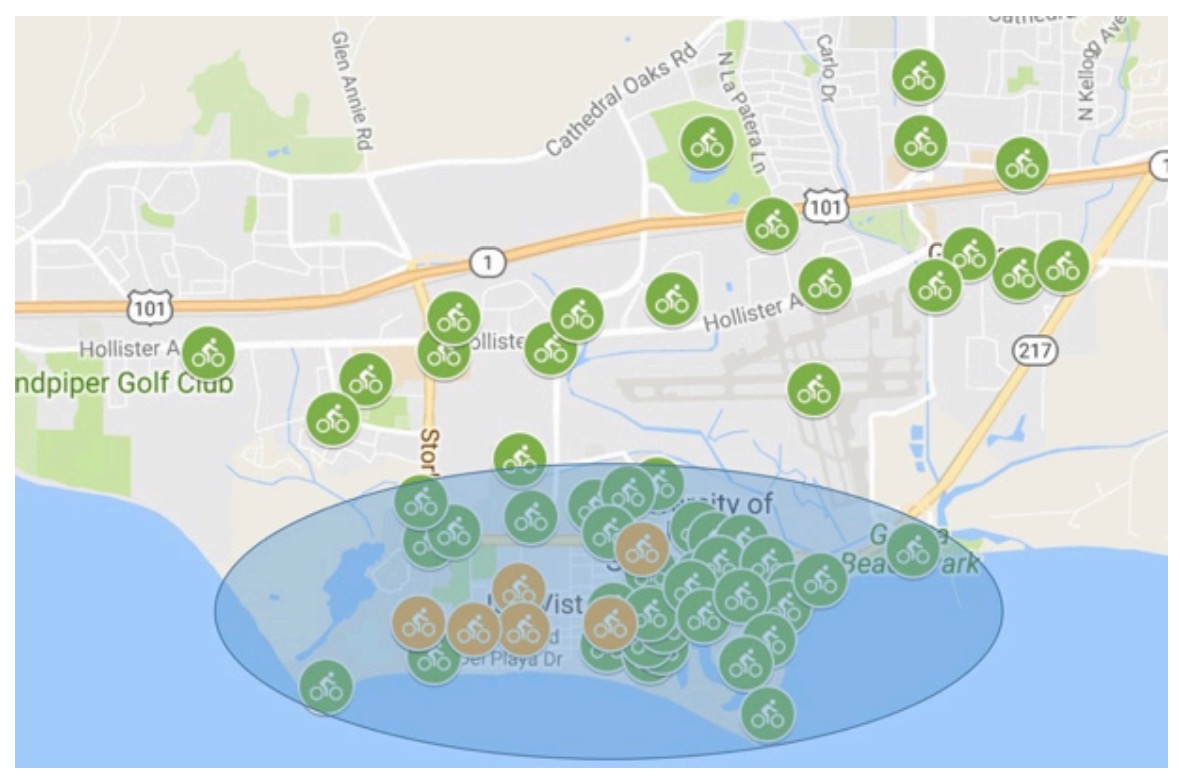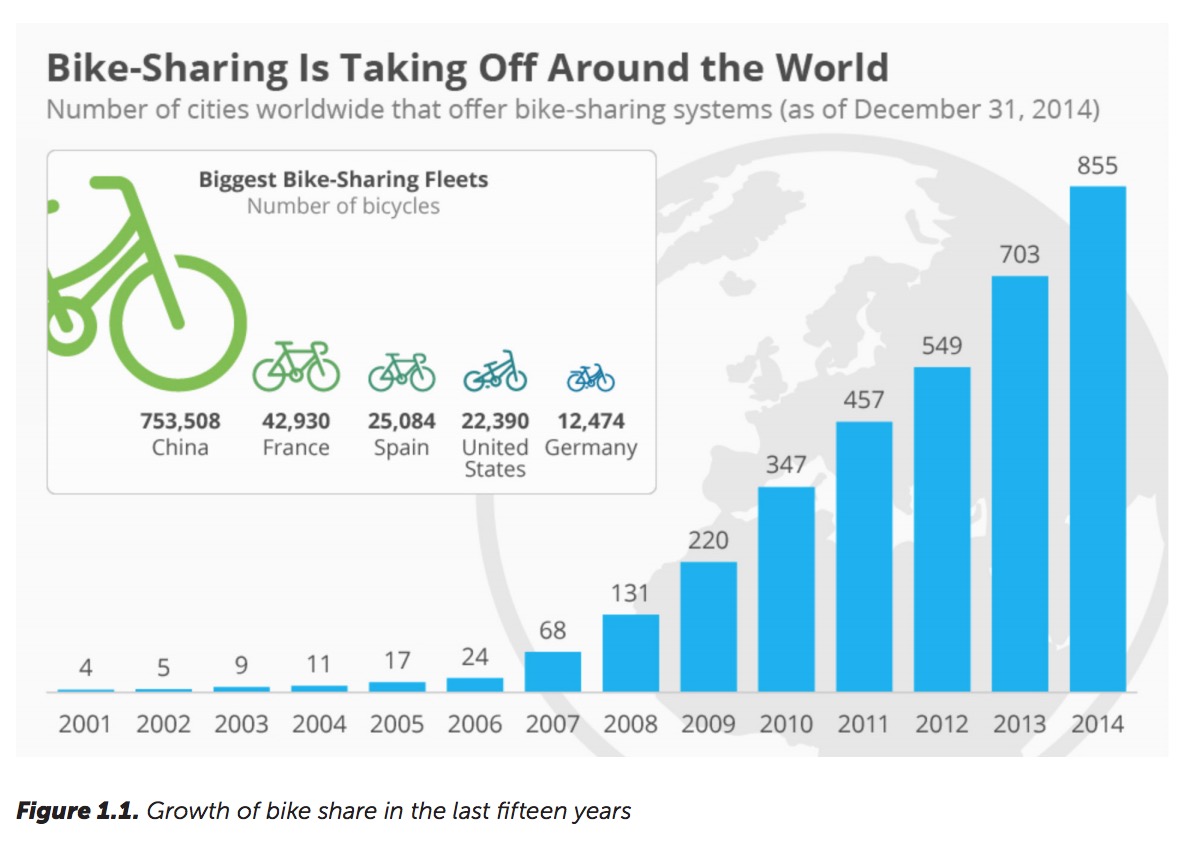UNIVERSITY OF CALIFORNIA, SANTA BARBARA, OFFICE OF SUSTAINABILITY
SANTA BARBARA CITY COLLEGE COMMUNITY FOUNDATION
SANTA BARBARA BICYCLE COALITION
Executive summary
 Bike share systems are a popular mode of city transportation offering the convenience and flexibility of a bicycle in an accessible public transportation model. Bike Share Systems consist of a managed network of bicycles allowing users to temporarily check out a bicycle as a quick and reliable way to carry out short trips, errands or connect to transit. Bicycle are available through a network of stations or virtual stations located through a defined area. While some systems require the user to return the bicycle to a designated station, the most modern systems allow for completing a trip without returning it to a specific station. Trips may be payed for through a membership system or a pay-as-you- go model.
Bike share systems are a popular mode of city transportation offering the convenience and flexibility of a bicycle in an accessible public transportation model. Bike Share Systems consist of a managed network of bicycles allowing users to temporarily check out a bicycle as a quick and reliable way to carry out short trips, errands or connect to transit. Bicycle are available through a network of stations or virtual stations located through a defined area. While some systems require the user to return the bicycle to a designated station, the most modern systems allow for completing a trip without returning it to a specific station. Trips may be payed for through a membership system or a pay-as-you- go model.
Bike share systems are a popular mode of city transportation offering the convenience and flexibility of a bicycle in an accessible public transportation model. Bike Share Systems consist of a managed network of bicycles allowing users to temporarily check out a bicycle as a quick and reliable way to carry out short trips, errands or connect to transit. Bicycle are available through a network of stations or virtual stations located through a defined area. While some systems require the user to return the bicycle to a designated station, the most modern systems allow for completing a trip without returning it to a specific station. Trips may be payed for through a membership system or a pay-as-you-go model.
The number of bike share systems in the United States is increasing dramatically as cities look for cost-effective ways to enhance mobility.
Santa Barbara County’s South Coast has numerous characteristics that indicate bike sharing would be a viable transportation mode, including:
- Year-round weather that makes biking enjoyable and convenient for traveling to local destinations.
- Numerous attractions and events that draw in hundreds of thousands of visitors each year.
- Diverse, dense, young and growing downtown areas that provide numerous destinations for residents and tourists.
- Large populations of students from international language schools, Santa Barbara City College and UC Santa Barbara.
- Areas with the highest population density also have the flattest topography.
There are also several challenges, that will need to be overcome for bike sharing to be successful, including:
- Any system will likely require some public funding.
- Perceived competition with existing bike rental shops will need to be minimized in order for the system to achieve broad support.
- While investment in bicycle infrastructure is increasing, a majority of the population lacks familiarity with bike share systems. This could translate into a political challenge for bike sharing to gain traction during the planning phases.
- Multi-jurisdictional systems such as those envisioned herein, may be difficult to organize, requiring high levels of coordination among implementing agencies.
There are three different general types of business models that can be used for the bike share system, some of which involve solely or a combination of the private, public and non-profit sectors. Regardless of which business model is chosen, each jurisdiction will need to play a role in permitting and funding the system.
Funding for the system can come in many forms— through a combination of public funding, private funding, corporate sponsorships and user revenues. Public funds are the most common source of funding generally with grants from on the federal, state and local levels seeking the traffic and health benefits of encouraging bicycling for short trips. Although public funding is the most widely available option, the system would need to have experienced staff to write the grant applications. While private funding is also an option, money can fluctuate on a year-to-year basis. Sponsorship and advertisements can also provide significant funds for the system – in some cases they supply a majority of funds for a bike share system. User revenues can be based on a combination of memberships and usage fees.
This report is intended to be a starting point for further discussion and outreach among the public, stakeholders, local businesses, and local agencies to evaluate the efficacy of a local bikeshare system, ensure that the system is planned correctly and that all concerns are addressed adequately. The South Coast Bike Share Initiative conducted this feasibility study process over the course of 2016, thanks to generous support by the Santa Barbara Bicycle Coalition, Santa Barbara City College, and the University of California – Santa Barbara.
Download full version (PDF): South Coast Bike Share Feasibility Report
About the UC Santa Barbara Office of Sustainability
www.sustainability.ucsb.edu
At the University of California, Santa Barbara our goals is to approach environmental issues head on and innovate solutions to improve the environment. We use the campus as a living lab and everyone has a role to play in making the campus sustainable. We foster a culture of sustainability through supporting campus-wide efforts, coordinating program development, and publicizing sustainability work by students, staff, and faculty.
About the Santa Barbara City College Foundation
www.sbccfoundation.org
The SBCC Foundation was established in 1976 to provide Santa Barbara City College with private philanthropic support. The foundation acts in partnership with the college and bridges the gap between available public funding and institutional need, as determined by the college leadership.
About the Santa Barbara Bicycle Coalition
www.sbbike.org
SBBIKE has been working to make Santa Barbara a great place to ride a bike for over 25 years. By working with City Administrators, Educators, and Planners, we’re putting Santa Barbara on track so that bicycling is safe, accessible, and enjoyable for everyone.
Tags: Bicycling, Bike Share, Bike Sharing, Bikeshare, CA, California, Cycling, Santa Barbara, Santa Barbara Bicycle Coalition, Santa Barbara City College, South Coast, UC Santa Barbara, University of California







 RSS Feed
RSS Feed